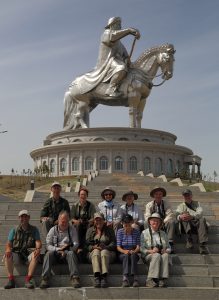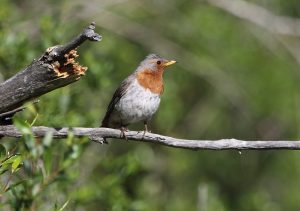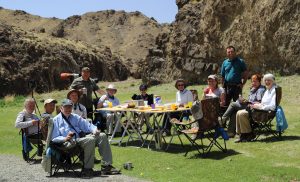The long approach into Ulan Bator at the eastern end of this mysterious landlocked country emphasises just how immense and empty it is, with seemingly endless miles of apparently uninhabited arid plains and rugged hills, intricately carved into dendritic patterns over the millenia by rare flash floods. Our arrival at our hotel in Ulan Bator is greeted with howls from a Peacock strutting around the hotel lobby, like he owns the place! In the absence of any ‘poop’ on the ‘deck’, he appears to be house trained! After a hearty lunch in the hotel we spend the afternoon in a powder-dry parkland on the outskirts of town, where the local residents include Ruddy Shelduck, the local black-billed longipennis race of Common Tern, Hoopoe, Azure-winged Magpie, black and white Daurian Jackdaws, White-cheeked Starlings, popping in and out of their nest hole, and plenty of Tree Sparrows.
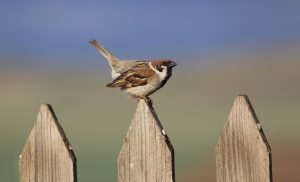
There are Choughs, Grey Wagtail and a singing Common Rosefinch right outside the hotel this morning as we check out. On the way out of Ulan Bator, another stop by the river produces Pacific Swifts, great views of Azure Tit and a dashing male Amur Falcon, while his missus poses on a nearby wire. After a couple of hours driving through a completely treeless landscape, grazed by herd after herd of sheep, goats, cows and horses (Mongolia has a population of around three million people and over sixty million livestock) we make a brief roadside stop, amid thousands of grasshoppers displaying by clapping their wings just above the ground, for Asian Short-toed Larks and considerably larger Mongolian Larks, with really smart rusty crowns and napes, black collars and large white wing flashes in flight. Further on in the Gun Galuut nature reserve, a number of shallow saline lakes in this otherwise dry landscape, teem with waterbirds including Pintail, Garganey, loads of Ruddy Shelduck, including a pair with fourteen downy ducklings, a pair of Whoopers with five cygnets, Avocets, Black-winged Stilts and Marsh Sandpipers galore, Eurasian Spoonbill, Mongolian Gull (like Caspian, but with greenish yellow legs), and about ten elegant White-naped Cranes, with Isabelline Wheatears and plenty more Mongolian Larks on the adjacent turf. After lunch at our tented camp, a further exploration of the area adds Short-toed Lark and the local white-faced brandti race of Horned Lark to the list, as well as a flock of at least two hundred White-winged Terns, along with a few Whiskered and one or two Gull-billed Terns. There is plenty more to see here such as Black-necked Grebe, a couple of Pacific Golden Plovers, two Eurasian Curlews with exceedingly long bills, several Stejneger’s White-winged Scoters and at least sixty-five Demoiselle Cranes. At one stage we have Falcated and Long-tailed Ducks in the same scope view, with the Long-tail being such a rarity here that it is a ‘lifer’ for our local guide!
Wow! Stepping out of the cosy yurt this morning reveals an ultra-bright, mega-clear, super-still tranquil morning in this completely treeless plain, backed on each side by rolling hills, under a cloudless blue sky. Minutes from camp a Black Vulture circles overhead, while a Rock Sparrow delivers food to its nest in an ancient man made ruin. A small lush green wetland in this largely arid landscape is alive with plenty more White-winged Terns, along with Common Snipe, Black-tailed Godwit, Marsh Sandpiper, Garganey, another exquisite Falcated Duck, a White-naped Crane on a nest with a single egg, a pair of Whoopers with four cygnets, at least eleven Swan Geese and a vivid yellow-headed male Citrine Wagtail. A flock of nine Pallas’s Sandgrouse flies by right in front of us, while Isabelline Wheatears and a Horned Lark forage the nearby dry ground. By now, an hour and a half have passed at this beguiling wetland and it’s time to move on via a long, long dirt track to a scenic valley with trees! After a lovely picnic lunch under the Larches the afternoon is very fruitful, starting with plum views from all angles of a very obliging Pine Bunting. Other great sightings here, mostly at very close range, include Olive-backed Pipit, Willow Tit, the white-bellied arctica race of ‘our’ Nuthatch, Dark-sided Flycatcher, Hume’s and Dusky Warblers, Taiga Flycatcher and Red-throated Thrush (both of which have ‘Robin-coloured’ throats) and a posing male Siberian Rubythroat, with a bright scarlet throat patch; so, try picking a star bird out of that lot!
It’s another gloriously clear, bright sunny day, with Isabelline Wheatear and Horned Lark singing in the camp grounds, which are next to a swift-flowing shallow river. Exploration of the scrub alongside the river exposes the Pallas’s Grasshopper Warbler, previously seen before breakfast yesterday by the group’s insomniacs! While looking for the warbler, a Little Bittern-type bird shows briefly as it scurries along the ground between the dwarf Willows, before breaking cover and landing further along the open river bank, where it sits pointing its sharp beak skyward, revealing a dark-streaked pale throat. It then flies past us back along the river showing white spotted brown wings, before disappearing back into the original Willows. By now we had seen enough to identify it as the rare Schrenck’s Bittern, whereupon our local guide, who is on the Mongolian Rarities Committee, declares that this is only the third record for Mongolia since records began in 1950, and the first ever record for this area of central Mongolia; and I found it! Yay!
Moving on from Steppe Nomads Ger Camp, we revisit one of the saline lakes, with an enviable list of the ‘usual suspects’ such as Ruddy Shelduck, Stejneger’s White-winged Scoter, Black-necked Grebe, Eurasian Spoonbill, Demoiselle Crane, Marsh Sandpiper, Mongolian Gull, White-winged and Whiskered Terns, and the incongruous combination of Whooper Swan and Black-winged Stilt. After another nice picnic amid one of the few clumps of trees for miles, bristling with millions of grasshoppers, an impressively high silver statue of the great Ghengis Khan, makes a fitting backdrop for a group photo. By late afternoon we are in a new landscape of towering rounded rock formations near Terelj, with a Black-eared Kite mobbing a Steppe Eagle. A boggy thicket rings with the tinkling songs of at least three Siberian Rubythroats, and although these songsters can be as notoriously shy as our Nightingales, one eventually pops up on the top of a bush for all to see, while a calling Common Cuckoo and another stunning Citrine Wagtail also pose nearby. A short stroll from the hotel leads to a mature woodland dominated by majestic Poplars, the first we have encountered on this trip, where a calling Oriental Cuckoo is our first sighting. How ironic that Anny has waited a lifetime for a Cuckoo and then two come along at once! Next on the list are Two-barred Greenish Warbler and Hawfinch, followed by the remarkable juxtaposition of male Common and Daurian Redstarts in the same scope view. Meanwhile, a pair of Lesser Spotted Woodpeckers peck away at opposite sides of the same tree trunk at eye level, and the very smart Daurian Redstart obligingly perches on a post for prolonged views in the scope, making a nice finale to another great day.
The mighty Black Woodpecker is first on the list this lovely sunny morning, as a red-capped male shoots by like a guided missile. Next up are a female Rock Thrush on top of a tall tree and a male Pied Wheatear on the rocks up above. This lovely wooded valley is alive with a variety of butterflies including the black and white Hungarian Glider, large white Apollos and Amanda’s Blue. Other good sightings include Common Rosefinch, Black-faced Bunting and the ultrasonic Yellow-browed Warbler, all singing close by, but the stars of the show have to be a Ural Owl with two well developed chicks starring into the scope with their dark chocolate eyes. After yet another lovely picnic, prepared by our dedicated team, this time beside a river, with Common Sandpipers and a drinking Black-eared Kite along the bank, we head for a valley lined by spectacular granite rock formations, hoping for Godlewski’s Bunting, and within just a few minutes a male is sitting stock-still on a nearby boulder! Not bad for a quiet day.

This morning we take the 6.30am flight from Ulan Bator, south to Dalandzadgad in the Gobi Desert, where a small plantation near the airport provides a green oasis for Barred Warblers, busy with their display flights, and Isabelline Shrikes. A noisy commotion among the shrikes and Tree Sparrows alerts us to the presence of an owl, which breaks cover as a Long-eared Owl, never to be seen again. Moving on to a second plantation, we find an Isabelline Shrike, shielding her nestlings from the heat of the sun, which reaches 30°C by 9.30am! By now we are also starting to pant, but carry on long enough to spot a Daurian Starling in one of the larger bushes. From here our camp is way off in the vast featureless expanse of a stony desert, covered by a sparse mat of scorched yellow grass, and accessible only by an apparently random network of indeterminate tyre tracks. After lunch and some time to chill out, we reconvene at 3pm and head out across the desert in search of anything capable of surviving in such a hostile environment. Incredibly there is life here in the form of Crested and Horned Larks and a ‘fly by’ Hill Pigeon, with its diagnostic black and white banded tail. A small reservoir on the other side of the town is unsurprisingly teeming with life, including Little Ringed and Kentish Plovers, and up to a hundred Greater Sand Plovers, plus one Lesser Sand Plover with a significantly shorter bill. The water also draws in two pairs of attractive Pallas’s Sandgrouse, which show really well, while the surrounding desert is home to a herd of two-humped Camels and a handsome Desert Wheatear. On the way back to camp, one final brief stop in a surprisingly verdant plantation produces close views of Siberian Chiffchaff, three Long-eared Owl chicks starring at us from their bulky nest platform and a vagrant Black Drongo from further east in China. With so much dust rising high into the sky above Dalandzadgad, the town resembles the aftermath of an airstrike, and on the drive back to camp, thickening black clouds threaten rain, but any precipitation quickly evaporates in the warm air before ever reaching the parched ground.
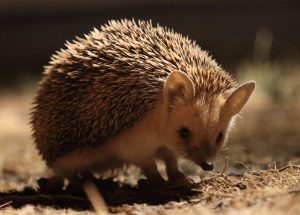
It’s cloudy, breezy and a fair bit cooler this morning, and the cute Long-eared Hedgehog nightshift around camp is replaced by a Tolai Hare, sheltering from the elements next to a couple of tyres, completely unperturbed by we campers, passing to and fro between the yurts and the ablutions. We begin by scouring the desert for Oriental Plover, but only find Pallas’s Sandgrouse and Horned Larks, before heading into the Altai Mountain range running along the western fringe of the vast desert plain. Not far into the mountains we spot an Upland Buzzard on a high rock and then a Saker Falcon carrying prey across the valley, before landing to tear apart the unfortunate catch. By now the sky is blue again and deeper into the mountains we find Rock Sparrow, Crag Martin, Mongolian Finch and the first of many Snow Finches, as well as Pallas’s Pikas, Mongolian Gerbils and Clouded Yellow and Swallowtail butterflies. Overhead another Saker cruises by and a pair of Upland Buzzards put on a great aerial show. This afternoon we explore Yolim Am, a deep valley lined by towering rock walls, patrolled by Eurasian and Himalayan Griffons and an awesome Lammergeier, while the valley floor produces Mongolian Accentor, looking like a washed out Dunnock, followed by Godlewski’s Bunting and a very obliging Brown Accentor. Deeper into the chasm, a very orange-bellied male Black Redstart puts in an appearance, followed by the unmistakable butterfly wings of a Wallcreeper, displaying the red, black and white pattern as it glides across the blue sky from one cliff to another. At the end of a productive valley walk, vestiges of last winter’s ice show just how cold it can get here, while a family of Siberian Ibex demonstrate how easily they can ‘hop’ across vertiginous rock faces. On the return walk the Snow Finches around our feet barely get a second glance, but we do stop for excellent views of an Oriental Cuckoo posing on one of the rocks, close enough to show the buff wash under the tail and the wider bars compared to ‘our’ Cuckoo. What a great day.
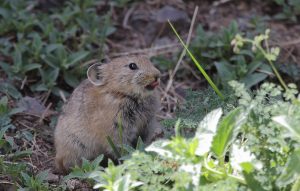
It’s a calm sunny morning as we wave goodbye to the lovely staff that looked after us so well over the last two nights in camp. More than an hour passes as we drive further west across the featureless and seemingly infinite expanse of the desert plain before reaching an outpost of ‘civilisation’, with a last opportunity to refuel and a green plantation to explore, finding Desert Wheatear and Pallas’s Leaf Warbler as well as the ubiquitous Tree Sparrows. Back on track we pass a herd of camels, plus Upland Buzzard, Saker Falcon, Pallas’s Sandgrouse and numerous Horned Larks, before stopping for a picnic lunch, quite literally in the middle of nowhere, surrounded by Variegated Toad-headed Agami Lizards, with black-tipped coiled over scorpion-like tails, as if to fool would-be predators. By mid afternoon we reach the rugged hills bordering the plain, which are home to Siberian Ibex, Lammergeier, Saker Falcon, Pied Wheatear, and Grey-necked Bunting spotted singing from the highest rocks. After an enthralling drive of some 125 miles, entirely on tyre tracks in the stony soil, journey’s end is the Khongoryn Els dunes, an impressive sandy spine stretching for hundreds of miles from east to west, and disappearing into a thick shroud of dust rising hundreds of feet into the air, obliterating the distant horizon and sky. Seeing such an apocalyptic scene, I casually comment that it seems reminiscent of “a disaster movie”; little did I know what was soon to pass. Within minutes of being allocated our yurts, the ‘mother of all sand storms’ rips through the camp, tearing away all un-tethered items, including Roberta’s favourite hat, while blasting everything in its path with so much sand that visibility is virtually zero. Inside each tent, hanging by a rope from the top frame, is a rock anchor, which is swinging to and fro, while the tent ‘lid’ has ‘gone with the wind’! Next comes near horizontal rain, and the scene becomes chaotic as the camp staff scurry back and forth in vain attempts to hold down the yurts, though resistance is futile as they buckle like paper bags under the strain of the storm-force battering. In the aftermath of this devastation, Uugan gives the order to evacuate the camp, and as some of the ladies can barely stand up straight against the raging wind, they are bundled towards the vehicles by the drivers, where we hastily reload the luggage, retreat to an alternative more sturdy set up nearby, and celebrate our ‘survival’ with plenty of beer. That is one experience we will never forget!
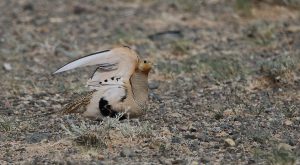
It’s just plain breezy this morning as we head towards the dunes for ‘Operation Sparrow’. Not far from camp we find a male Lesser Kestrel, showing nicely on a low perch, followed by close views of another pair of Pallas’s Sandgrouse and three Demoiselle Cranes. The edge of the dunes is bordered by a snake-like shallow river which has carved cliffs out of the sand, where we find Ruddy Shelduck, Black-eared Kite, Upland Buzzard, Little Ringed Plover, Hill Pigeon, Desert Wheatear, Isabelline and Steppe Grey Shrikes, and several Black Vultures and Ravens, which must thrive on fatalities in this incredibly harsh environment. Meanwhile, the soaring Black Vultures draw our attention to an unusual ‘sunbow’ in a U-shaped arc below the sun. It’s now high noon and an Upland Buzzard chick is panting on its open nest platform on the top of a Saxaul bush. This dry scrub is one of the few places to see the scarce Saxaul Sparrow and we soon locate a chirpy male with his smart black bib, black crown and eye-stripe, separated by a rich sandy supercilium; mission accomplished!
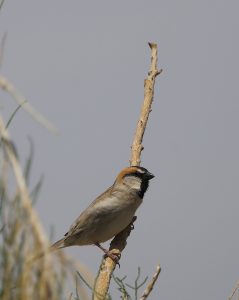
We have two target birds this afternoon, starting with the highly prized Mongolian Ground Jay, and our search of a rolling moraine-type area reveals a group of five Goitred Gazelles, before we connect with the unmistakable jay, with a long curved beak and black crown, scurrying around amongst the sparse shrubbery, and showing really well for all to enjoy. Heading back to the dunes we steer around a pair of Greater Sand Plovers with at least one fluffy little ‘clockwork’ chick, before getting several close views of Asian Desert Warbler, flitting between the scrubby bushes, rather like a Dartford Warbler in the Heather on Dunwich Heath. So, all the day’s target birds are ‘in the bag’ and we can return to camp to enjoy a shower, dinner and the gently changing contours of the magnificent scenery as the sun slowly sets, leaving a lovely pink flush to the wispy clouds in the afterglow. What a difference a day makes!
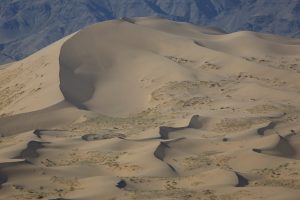
Another beautiful morning in a wonderful setting, as the clear morning light brings out the softly curving waves in the sea of sand, which has a mesmerising effect as we travel back to Dalandzadgad, spotting Mongolian Ground Jay, Steppe Grey Shrike, Black Vulture, two Lammergeiers, herds of camels and racing groups of Goitred and Mongolian Gazelles along the way. A brief mid morning stop at a tiny green plantation, miles from anywhere, produces Eurasian Collared Dove sitting alongside a beautifully marked Oriental Turtle Dove, and House Sparrows! How on earth did they find the place? A good two hours drive further on, a much larger green oasis makes a convenient place for a picnic, and while the team prepares the meal, we find plenty more Horned Larks and Isabelline Wheatears, plus several Common Rosefinches, Hoopoe and a vagrant male Chinese Grosbeak! This awesome landscape is an enigma, with a vast emptiness, yet so full of magical surprises that every journey here is a fabulous adventure for which there are insufficient superlatives.
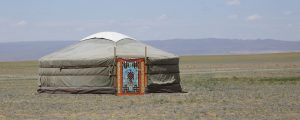
An early flight back to Ulan Bator lands us in pouring rain and a temperature half what it was in the Gobi, but by the time we reach our last camp, near Hustai National Park, the rain has stopped. This sandy area is crawling with small mammals such as Brandt’s Voles, Mongolian Gerbils, Long-tailed Ground Squirrels and not so small Tarbagan Marmots. No wonder we do so well for raptors here, with great views of Upland Buzzards and Saker Falcons at their nests on telegraph poles, plus a low flying sub adult Golden Eagle, as well as Steppe Eagles on the ground, and in flight alongside Black Vultures. Other good birds here include a pair of Demoiselle Cranes with a tiny chick, Mongolian and Asian Short-toed Larks, Isabelline, Northern and Pied Wheatears, Choughs and beautifully marked Meadow Buntings, while the large mammals are represented by Red Deer hinds and stags, Mongolian Gazelles and a couple of dozen Przewalski’s Horses, which are a rich sandy colour, with neat black manes and matching black legs and tails.
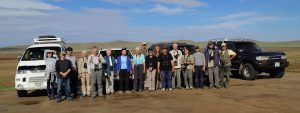
You know you’re having a good time when you no longer know what day of the week it is, but I do know today is the longest day and very sadly our last in the field. After a photo of the whole team, we set off for Bayan Lake, with the usual Sakers, Upland Buzzards and Black Vultures along the way. Due to the recent prolonged drought, the lake is virtually dry, but a small pool covered in Gadwall, Pintail, Shoveller, Teal and Wigeon also harbours a drake American Wigeon, while further observation of the area produces loads more good stuff such as Temminck’s Stint, White-naped and Demoiselle Cranes, Paddyfield, Pallas’s Grasshopper and croaking Oriental Reed Warblers, Bearded Tits and the stunning Manchurian race of Eastern Yellow Wagtail. Throughout the ninety plus minutes in this one spot, a Richard’s Pipit sings insistently above us, with occasional landings, showing just what an ‘upright citizen’ he is and we finish the morning with great views of an Upland Buzzard on the ground at relatively close range. While all this was going on our team have laid out another super three course spread for lunch in the lovely sunshine, surrounded by hundreds of free range sheep, goats and horses and singing Mongolian and Asian Short-toed Larks. This afternoon, the action continues with a superb male Eastern Marsh Harrier in a high dipping display flight, and a Chinese Pond Heron, which in flight, resembles a giant White-winged Tern. The red throats of the local Barn Swallows bleed all the way down their underparts, making them look completely rusty below, while the eastern Greylags have rosy pink bills instead of the more familiar orange back home. This fabulous wetland is also the easternmost breeding site of neatly patterned Bar-headed Geese, currently with downy goslings, having a paddle alongside a herd of horses and a family of rare Swan Geese, with one gosling, and a pair of Ruddy Shelducks with fifteen downy ducklings! No wonder these are so common here. In addition to a pair of White-naped Cranes with a single chick, there is a pair of Common Cranes with two chicks, making this a ‘three crane day’! With Gull-billed Terns earlier on, we finish up here with a party of Common, Whiskered and lovely White-winged Terns, making it a ‘four tern day’ as well. On the journey back to camp, the ever-changing scenery is enhanced by ‘dust devils’ highlighted against a dramatic black sky with occasional streaks of lightening.
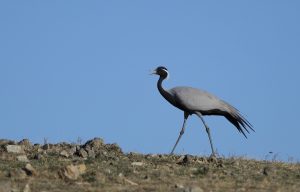
With so much spectacular scenery, wonderful wildlife, glittering night skies and great people, Mongolia is simply amazing, and we were quite literally blown away by this remarkable adventure.

